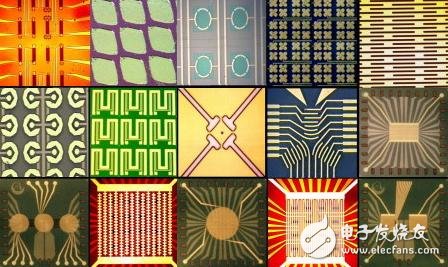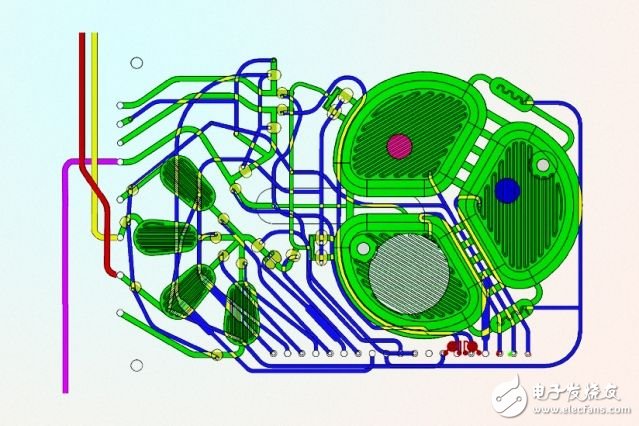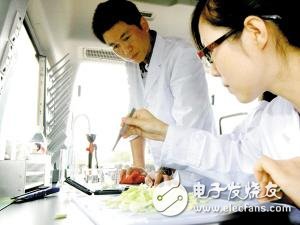Biochip refers to the method of in situ synthesis or micro-spotting of light guides to form a large number of biological macromolecules such as nucleic acid fragments, polypeptide molecules or even tissue sections, cells and other biological samples on the surface of the support in an orderly manner. The dense two-dimensional molecular arrangement is then hybridized with the target molecule in the labeled biological sample to be tested, and the intensity of the hybridization signal is detected and analyzed rapidly, in parallel, and efficiently by a specific instrument to determine the number of target molecules in the sample. Since the conventional silicon wafer is used as a solid phase support and the preparation technology of the computer chip is simulated in the preparation process, it is called a biochip technology.
Biochip classification
Although the biochip has only a history of more than 10 years, it contains many types, and the classification methods and types are not completely unified.
1, use classification
(1) Bioelectronic chip: used in the manufacture of bioelectronic products such as biocomputers.
(2) Bioanalytical chip: used for the detection of various biological macromolecules, cells, tissues, and biochemical reactions.
The former category is currently immature in technology and applications. In general, the biochips referred to are bioanalytical chips.
2. Classification of action modes
(1) Active chip: It integrates multiple experimental steps such as sample processing and purification, reaction labeling and detection in biological experiments, and can be actively completed through one-step reaction. It is characterized by its fast and simple operation, so it is called a functional biochip. It mainly includes microftuidic chips and lab on chips (also called "chip labs", which is the high level of biochip technology).
(2) Passive chip: that is, various microarray chips, which refer to the integration of multiple experiments in biological experiments, but the operation steps are unchanged. It is characterized by a high degree of parallelism, and most of the current chips fall into this category. Since such chips mainly obtain a large amount of biomacromolecular information and finally perform data mining analysis through bioinformatics, such chips are also called information biochips. Including gene chips, protein chips, cell chips and tissue chips.
3. Composition classification
(1) Gene chip: Also known as a DNA chip or a DNA microarray, a cDNA or an oligonucleotide is immobilized on a microcarrier in a microarray manner.
(2) Protein chip or protein microarray: It is obtained by immobilizing some non-nucleic acid life substances such as proteins or antigens on a microcarrier by microarray. The probes on the chip are composed of proteins or chips. The objects of the proteins are collectively referred to as protein chips.
(3) Cell chip: A cell is immobilized on a carrier in a specific manner to detect interaction or interaction between cells.
(4) Tissue chip (TIssue chip): A tissue slice or the like is fixed on a carrier in a specific manner, and is used to carry out research on compositional differences in tissues such as immunohistochemistry.
(5) Others: such as Lab on chip, a miniaturized chip for separation and detection of living matter. Now, many researchers have tried to microfilm the entire biochemical detection and analysis process to form a so-called "Lab on chip". The chip lab is the ultimate goal of the development of biochip technology. It intensifies the entire process of sample preparation, biochemical reaction and detection and analysis into a micro-analysis system. A chip lab consisting of a heater, a micropump, a microvalve, a microfluidic controller, a microelectrode, an electrochemistry, and an electroluminescence detector has been introduced, and partial integration of biochemical reactions, sample preparation, detection, and analysis has emerged. Chip). The "Chip Lab" can perform a series of complex tasks such as sample preparation, reagent delivery, biochemical reactions, results detection, information processing and delivery. These miniature integrated analysis systems are easy to carry and can be used in emergency situations, field operations or even on spacecraft.
For example, the preparation of the sample and the PCR amplification reaction can be completed simultaneously on a small chip. Another biochip designed and manufactured by Gene Logic can separate DNA from the sample to be tested and fluorescently label it, then when the sample flows through the oligonucleotide probe immobilized in the palisade-like microchannel. A target nucleic acid sequence complementary thereto can be captured. The detection and analysis of hybridization results can be achieved by using its own developed detection equipment. Such a chip can sensitively detect changes in rare genes due to the large adsorption surface area of ​​the oligonucleotide probe. At the same time, since the microchannel designed by the chip has concentration and enrichment, the hybridization reaction can be accelerated, the test time is shortened, and the test cost is reduced.
Biochip application field
1. Biopharmaceutical field
Major pharmaceutical companies and biotechnology companies will use gene chips to discover new drugs. Gene chip technology can greatly accelerate the progress of the Human Genome Project, such as gene sequencing, gene expression detection and new genetic markers such as SNP mapping, which are aimed at finding new functional genes, finding new drug targets and The development of new genetic drugs is of great significance. The use of gene chips allows for the detection of gene expression changes in different species, different tissues, different diseases, and different processing conditions beyond the previously imagined workload, thereby knowing the development of diagnostic kits for different uses. The new drug must pass the human safety experiment in the experimental stage, and it is necessary to observe the effect of the drug on human gene expression. Since it is not known that the drug acts on that gene, it is necessary to carry out all or a certain range of gene expression. Detection, using gene chips can accomplish this task quickly and accurately.

2, medical diagnosis
2.1. In terms of eugenics, it is currently known that there are more than 600 genetic diseases associated with genes. Women using DNA chips for genetic diagnosis in early pregnancy can avoid many genetic diseases.
2.2 In the diagnosis of diseases, since most diseases are related to genes and often related to multiple genes, DNA chips can be used to find the correlation between genes and diseases, so as to develop corresponding drugs and propose new treatment methods. The high-density information of DNA chips and the advantages of parallel processors not only make multi-gene analysis possible, but also ensures efficient, inexpensive, fast and easy diagnostics.
2.3, applied to organ transplantation, tissue transplantation, cell transplantation, genetic matching, such as HLA typing.
2.4, pathogen diagnosis, such as bacterial and viral identification, identification of drug resistance genes.
2.5. In terms of the impact of the environment on the human body, it is known that the human body's response to the environment, such as pollen allergy, is related to genes. Comprehensive monitoring of more than 200 genes related to environmental pollution will have important implications for ecological environment control and human health.
2.6. In forensic science, the DNA chip is further developed than the earlier DNA fingerprinting. It can not only perform genetic identification, but also depict the facial appearance of the living body through the life information contained in the DNA. This type of test is often used to identify the identity of a corpse after a disaster and to identify the kinship between the parent and the child.

Fiber optic biochip for detecting blood sugar levels
3. Application of biochips in food safety
Food is food to safety first. Adequate nutrition and safe foods are essential for human survival. The application of biochip biosafety and food safety testing has just begun, but has shown advantages.
3.1. Detection of pathogenic pathogens in food chips by food chips
PCR-based viral nucleic acid detection technology is currently the main method of virus detection, but it is difficult to meet the requirements of simultaneous detection of multi-subtype or multi-virus, and the technology has the disadvantage of high contamination and false positive gene chip technology can be more Parallel detection of indicators, simultaneous detection of multiple viruses and multiple subtypes of viruses, is currently a hot research method for virus detection.
3.2. Detection of gene chips in food-borne viruses
Traditional methods for food-borne viruses mostly use serological immunology or real-time PCR to perform a single test on a certain virus. When a certain type of food needs to be tested, the efficiency of the traditional method is very low. . Wang Lin et al. [9] of Beijing Entry-Exit Inspection and Quarantine Bureau set up a platform for plant virus and early damage gene chip detection technology in plant-derived foods. It was first used for phytosanitary quarantine of plant viruses in China. The technology is low cost and only standard. 7% of the reaction system saves 100 yuan per reaction, breaking through the application bottleneck of the gene chip and achieving high-throughput rapid detection.
3.3. Application of gene chip in the detection of genetically modified food
In 2007, Zheng Wenjie of Tianjin Entry-Exit Inspection and Quarantine Bureau and other purified kits for genomic nucleic acids of seven genetically modified crops that have been commercialized at the same time can simultaneously detect a variety of crops and multiple genes, in view of the commercialized genetically modified products. More than 5 genes are involved. Therefore, the application of gene chip technology to establish high-throughput detection methods has obvious advantages in detection. The research group developed four types of transgenic product detection gene chips, such as a broad-spectrum screening chip species screening chip line detection chip and a comprehensive screening chip. The detected genes are mainly divided into three categories, a total of 46, covering all commercial transgenes. Plants and their products have solved the problem of the detection of genetically modified products in the world.

As an emerging molecular biology technology, biochip has the advantages of rapid, high throughput and high specificity. Applying this technology to the food safety field will inevitably bring new opportunities for the application of biochips and the improvement of food safety testing. To make biochip technology out of the laboratory, from the research into the food safety field closely related to the lives of ordinary people, the popularization and application of this technology will inevitably lead to the acceleration of detection speed and the reduction of testing costs, thus greatly strengthening law enforcement agencies such as Law enforcement by food safety testing agencies, entry-exit inspection and quarantine bureaus, and commodity inspection bureaus to ensure food safety and create good social benefits.
Copper Lugs,Copper Cable Lugs,Plating Copper Cable Lugs,Copper Tube Terminal Lugs
Taixing Longyi Terminals Co.,Ltd. , https://www.txlyterminals.com
